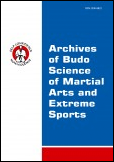2016, Volume 12, Issue 1
Effects of interval training modes on development of special physical qualities of athletes involved in hand-to-hand fighting
Xiaoquan Zhang1, Sergey Maximovich Ashkinazi2, Evgeniy Alexadrovich Bavykin3, Konstantin Valerevich Klimov2
1Key Lab of Training Control & Evaluation in Hubei Province, Wuhan Sports University, Wuhan, China
2Lesgaft National State University of Physical Education, Sport and Health, St. Petersburg, Russia
3National Mineral Resources University, St. Petersburg, Russia
Author for correspondence: Sergey Maximovich Ashkinazi; Lesgaft National State University of Physical Education, Sport and Health, St. Petersburg, Russia; email: sergei_ashkinazi[at]mail.ru
Full text
Abstract
Background & Study Aim: The analysis of scientific researches on the issues of developing hand-to-hand fighting athletes’ physical qualities has shown that in recent times the specialists in the field of sports have focused their attention on studying and selecting the most effective tools and methods of physical training that make higher demands on the functional systems of the athlete’s organism the capabilities of which determine the success of competitive activity. The purpose of the research are the cumulative effects of different variants of physical loads on physical fitness of the athletes engaged in hand-to-hand fighting and recommendation for the most efficient work modes aimed at developing special physical qualities.
Material & Methods: In 6-week experiment participated 60 students of 16-18 years old specialists in different styles of martial arts: sports combat sambo, hand-to-hand fight, universal fight, jiu-jitsu. The control group (CG, n = 30) and the experimental one group (EG, n = 30) trained 2 times a week by different methods. In EG work was carried out with the exception of loads of glycolytic direction, with weights of 70% of the conditional maximum (CMax), with a small number of repetitions (3 to 5), with rest intervals (1 min) and with a large number of rounds (10 to 15). For the CG the main method of training was a circular one. The time of exercise was 30 s, the weight was 70% of the CMax for basic exercises (barbell squat, deadlifts, clean and jerk) and from 30% to 40% of the maximum for isolated exercises (barbell stretching and bending of arms), a rest between exercises was 30 s, the number of rounds was 4 to 5, a rest between rounds was 2 to 3 min.
Results: The experimental methods allowed significantly better compared with the traditional methods to improve strength endurance of muscles of legs, back and shoulders of the athletes and to increase their recovery rate after exercise.
Conclusions: When implementing the complex of exercises for development of speed-strength abilities, it should be taken into account that effective implementation of methods is possible with a weight of 70% of CMax, with a low number of repetitions (3 to 5), a rest interval (1 min) and a large number of rounds (10 to 15). The intensity of the exercise and the weight should correspond to the performance model of the approximately maximal exercise in which work is carried out with the participation of fast muscle fibres, and the duration of the exercise needs to match ATP and CRP consumption in fast muscle fibres.
Key words: strength training, strength, microcycle, maximum strength, endurance





